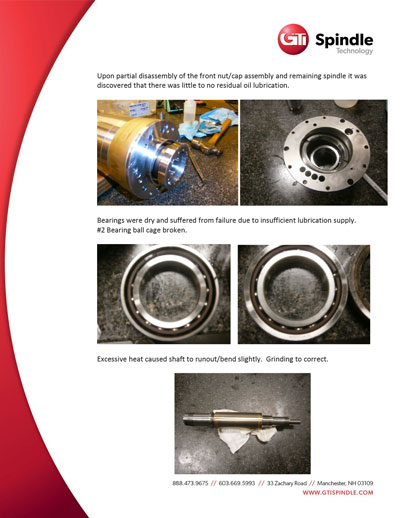When a spindle of yours fails, do you simply send it out for repair without getting a full understanding of why it failed? If so, sure, you’re minimizing downtime in that exact moment — but without determining the cause of the failure and fixing that as well, you’re likely dooming the spindle to fail again and again. When all is said and done, it’s the notably more expensive option.
Understanding the Cause(s) of Spindle Failure
To avoid a constant cycle of failure and repair, it’s essential that you understand why your spindle failed in the first place. Fixing issues that damage your spindle will, naturally, extend your spindle’s life and reduce your repair bill. Additionally, a root cause failure analysis can help you:
- Increase efficiency
- Reduce unplanned downtime
- Lower energy consumption
- Conserve labor and other resources
- Possibly avoid failure of the spindle that was put in service to replace the one that was pulled for repair
 But what exactly is a root cause failure analysis? It’s essentially a top-to-bottom report on your damaged spindle, including analysis of the spindle itself, its fault, and the equipment in which it was being used.
But what exactly is a root cause failure analysis? It’s essentially a top-to-bottom report on your damaged spindle, including analysis of the spindle itself, its fault, and the equipment in which it was being used.
At a reputable repair shop, the process starts with vibration analysis. At GTI, this is the first thing we do to every spindle that crosses our door. Often — at least once a month, without fail — our vibration analysis indicates that the spindle is perfectly healthy. When this happens, we work with the client to determine what in their setup caused the appearance of failure or part quality deviations/non-conformance where none existed. In scenarios like this, the most common culprits are unbalanced tool holders or low drawbar retention force.
If vibration analysis does indicate that there is an issue with the spindle, the next step of a root cause failure analysis is disassembling the spindle and inspecting it, component-by-component. This step gives technicians a good idea of what caused the damage and ultimate failure of the spindle.
The third step is, when applicable and practical, on-site inspections of the spindle-operating machinery. In the same way that improperly adjusted or operated machinery can cause a spindle to appear to malfunction, the same things can cause actual damage. For example: prematurely damaged bearings indicate a potential lubrication issue, which on-site inspection of the lubrication system can either confirm or rule out. Other issues that the on-site portion of a root cause failure analysis can uncover (that might be overlooked without it) include:
- Malfunctioning chillers — Spindles can easily overheat, leading to deformation and damage, if delivered coolant is dirty or is not the correct temperature
- Blocked air purge — A spindle’s air purge port helps maintain positive air pressure 0on the interior of the spindle assembly; without it, contaminates can enter the spindle and cause damage
- Unbalanced tool holders and/or damaged tooling
- Machine and/or operator/programmer induced overloads or impacts/crashes
Then, last but not least, is the written report. All the information collected by a repair technician during a root cause failure analysis is useless if it is not shared with the maintenance team and operators.
At many spindle service/repair shops, they skip an initial vibration analysis and go straight to disassembly — so you’ll be billed for that labor even if nothing is wrong with the spindle. If there is damage, they’ll repair it, box it up, and ship it back to you. You’ve got a functioning spindle, but no knowledge of why it broke in the first place.
The GTI Difference
GTI keeps you in the loop every step of the way. If our vibration analysis indicates a healthy spindle, we’ll contact you and arrange an onsite to avoid the cost of disassembly. If our evaluation indicates damage, we’ll help you identify its cause. And when we delivery your newly repaired spindle, we send a full report along with it.
